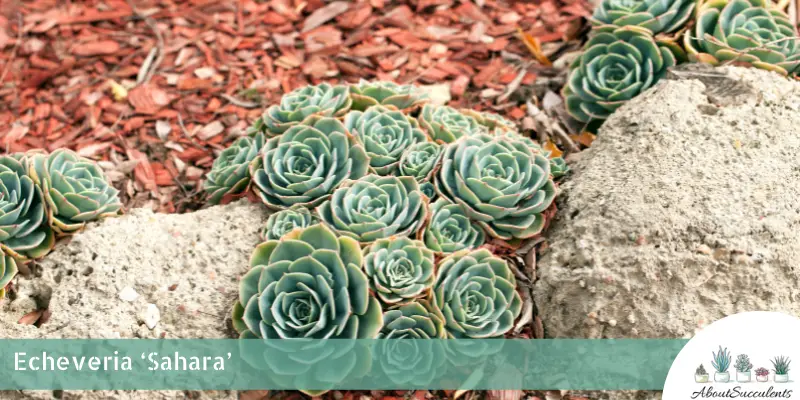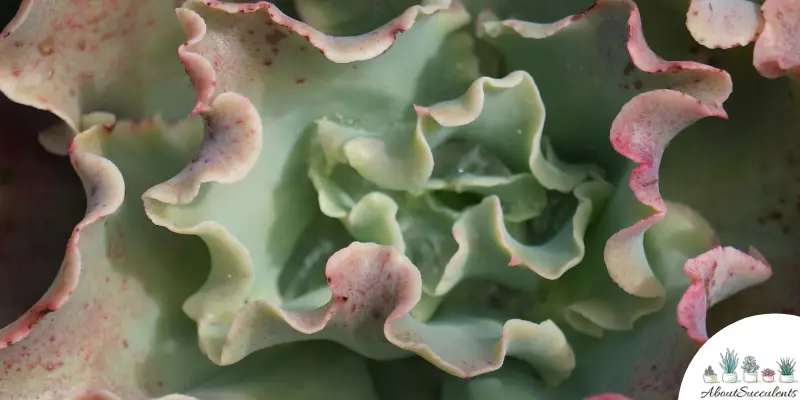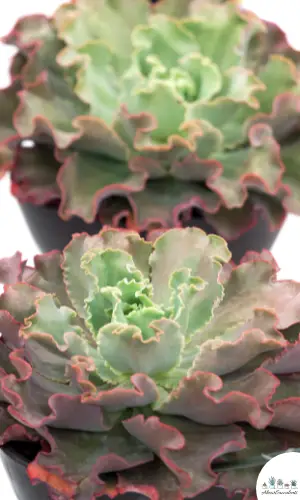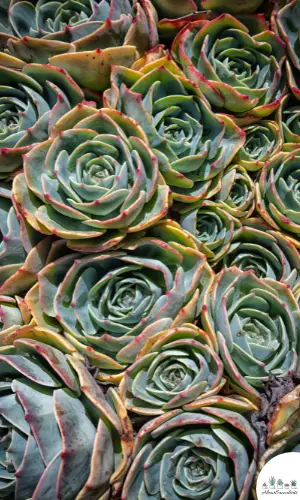
Echeveria sahara is a mesmerizing succulent that grows frilly, blue-green ruffled leaves with edges that turn pink when given direct sunlight on a daily basis. In the summertime, and with proper care, you’ll be gifted with coral-colored flowers that are larger than those produced by other echeverias.
A member of the Crassulaceae family and native to Mexico and the mountainous terrains of Central America, Sahara can grow up to a height of 8-inches (20.32cm) with a width of 12-inches (30.48cm).
Sahara is a variant of the Echeveria cultivar that’s fast becoming the preferred choice of succulent hobbyists and landscapers not only for its alluring beauty but also because of its greater durability.
Echeverias are known to be drought-tolerant but Sahara appears to be more resistant to extreme heat conditions. Also, while echeverias aren’t cold-hardy, Sahara has been studied to be more resilient against the effects of harsh frosty temperatures.
Echeveria sahara has also been observed to be highly resistant to specific types of pathogens and diseases that are known to compromise the health of succulents. These pathogens and diseases include Rhizoctonia, Powdery Mildew, and Fusarium.
General Information
Also known as: Sahara
Plant Family: Crassulaceae
Origin: Mexico and Central America
Height: 8-inches (20.32cm)
Exposure: Partial to full sunlight for up to 6 hours but to get the leaves to attain their maximum color and to have the pink-colored edges, exposure to full sunlight is better.
Water Needs: Give the soil a thorough soaking once you’ve confirmed with your tests that the soil is completely dry.
Soil Type: Well-draining sandy, cactus, or commercial succulent soil mix with added materials such as perlite, pumice, coarse sand, and lava rocks to improve drainage.
Soil pH: 6
How To Grow And Care For Echeveria “Sahara”

Echeveria sahara is a captivating succulent that will become an instant conversation piece in your outdoor garden. But how about as a houseplant?
A common question that’s asked about Sahara is how it responds to being grown in an indoor environment.
Like other species of Echeveria, Sahara will do just fine when you grow it inside your home. In fact, if the temperature in your region falls below 30°F ( -1.1°C), it would be better to plant Sahara in a pot that can be moved indoors.
As we’ll explain in this section, Echeveria sahara is a no-frills succulent plant that’s easy to grow and care for.
Sunlight
Echeveria sahara does well when given full to partial sunlight. However, to help Sahara achieve its maximum beauty, in particular the rich colors of its leaves and the pink-tipped edges, the succulent must be given full sun exposure every day.
Plant Sahara in an area in your outdoor garden that receives 6 hours of partial to direct sunlight. Avoid exposing this type of Echeveria to the burning rays of the afternoon sun.
And if you’re transferring your Sahara from the indoors to the outdoors, do it slowly. Start out with partial exposure for a few days before giving it full sunlight.
As an indoor plant, if you don’t have an area that gets direct sunlight, exposure to partial sun for up to 6 hours will be good enough. You might want to consider placing Sahara under a Grow Light.
Watering

Echeveria sahara stores water in its leaves and stems and can survive long periods without water. If you forget to water this plant, don’t stress over it. You actually did better by not watering frequently.
The golden rule when it comes to watering succulents is to give them water only when the soil has been tested to be 100% dry. If you water the soil while there’s still moisture, you will cause the roots to rot.
You can buy a Hygrometer to check the level of moisture in the air but a simpler method is to just insert a stick an inch into the topsoil.
Does the stick feel dry? If so, then prepare to give the soil a thorough soaking. During the dry summer season, you might find yourself watering the soil every 10 days. In contrast, you might be giving Sahara water only once a month when it’s winter.
Pot and Soil
When choosing pot and soil for Echeveria sahara, prioritize drainage. To keep Sahara healthy and alive, the soil must dry out as fast as possible. If the succulent’s roots are kept in a moist environment, the cells will rupture and the plant will get infected.
The best pot to buy is one that’s made of unglazed ceramic or terracotta as these materials are porous and allow moisture to escape along its sides. The pot must be large enough to allow Sahara’s roots to grow.
Make sure that the bottom of the pot has a drain hole with a mesh net cover to keep excess soil from falling out.
Echeveria sahara will grow best in sandy soil such as cactus mix or a commercial brand of succulent soil. To improve drainage, add materials such as perlite, pumice, lava rock, and coarse sand.
How To Propagate Echeveria “Sahara”

There’s another reason why Echeveria sahara is a great addition to your succulent garden. You can propagate the species through cuttings or offsets. Sahara will produce “pups” or offsets that grow near the base of the plant.
Cuttings Method
Step 1: Cut a healthy stem with a pair of sharpened and sterilized garden shears.
Step 2: Let the stem cuttings dry out in a clean area for 2 to 4 days or until it develops hard calluses.
Step 3: When the stem cuttings have enough calluses, place it on top of well-draining soil.
Step 4: Lightly water the soil and give it regular sun exposure until the roots have taken hold.
Step 5: Once the roots have firmed up, water the soil only when it’s completely dry.
Offsets Method
Step 1: Gently pull up the offsets that are growing near the base of the main plant.
Step 2: Allow the offsets 2 to 4 days to dry out or until you see the appearance of calluses.
Step 3: Plant the offsets in well-draining soil.
Step 4: Place the pot in a location that gets partial to full sunlight and lightly water the soil until the roots have developed.
Step 5: When the roots have taken hold in the soil, only water after you’ve confirmed its level of dryness.
Frequently Asked Questions
Is Echeveria “Sahara” Toxic For Cats And Dogs?
Echeveria sahara doesn’t appear in the list of plants that are toxic to cats and dogs on the website of the American Society for the Prevention of Cruelty to Animals (ASPCA).
Why Is My Echeveria “Sahara” Dying?
Echeveria sahara has been proven to be highly tolerant of drought, a minimum level of frost, and some varieties of bacteria and pathogens. However, it’s not immune to the negative effects of overwatering.
A common thread in our article is the importance of keeping track of Sahara’s watering schedule. You must only water the soil and give it a good soaking when it’s been tested and confirmed to be bone dry.
Prolonged exposure to moisture will lead to root rot and when this happens, the infection can spread throughout Echeveria sahara right away.
You’ll know this is the situation when you see discoloration or dark brown-yellowish spots appear on the plant’s leaves and stems. When you notice these spots, act immediately.
Get a sterilized pair of garden shears or a knife and cut off all of the infected parts to limit the area of contamination. Gently uproot the plant and cut off the roots that have rotted beyond salvation.
Place sahara in a dry area while you prepare a new pot by filling it up with a cactus mix or well-draining sandy soil. Replant Echeveria sahara and remember the golden rule of watering – give water only when the soil is 100% dry.
Yes, Echeveria sahara will produce coral-colored flowers during summer. A big plus with this species of Echeveria is that the flowers are larger than others.
Last Updated on June 9, 2022 by Sofia Lara